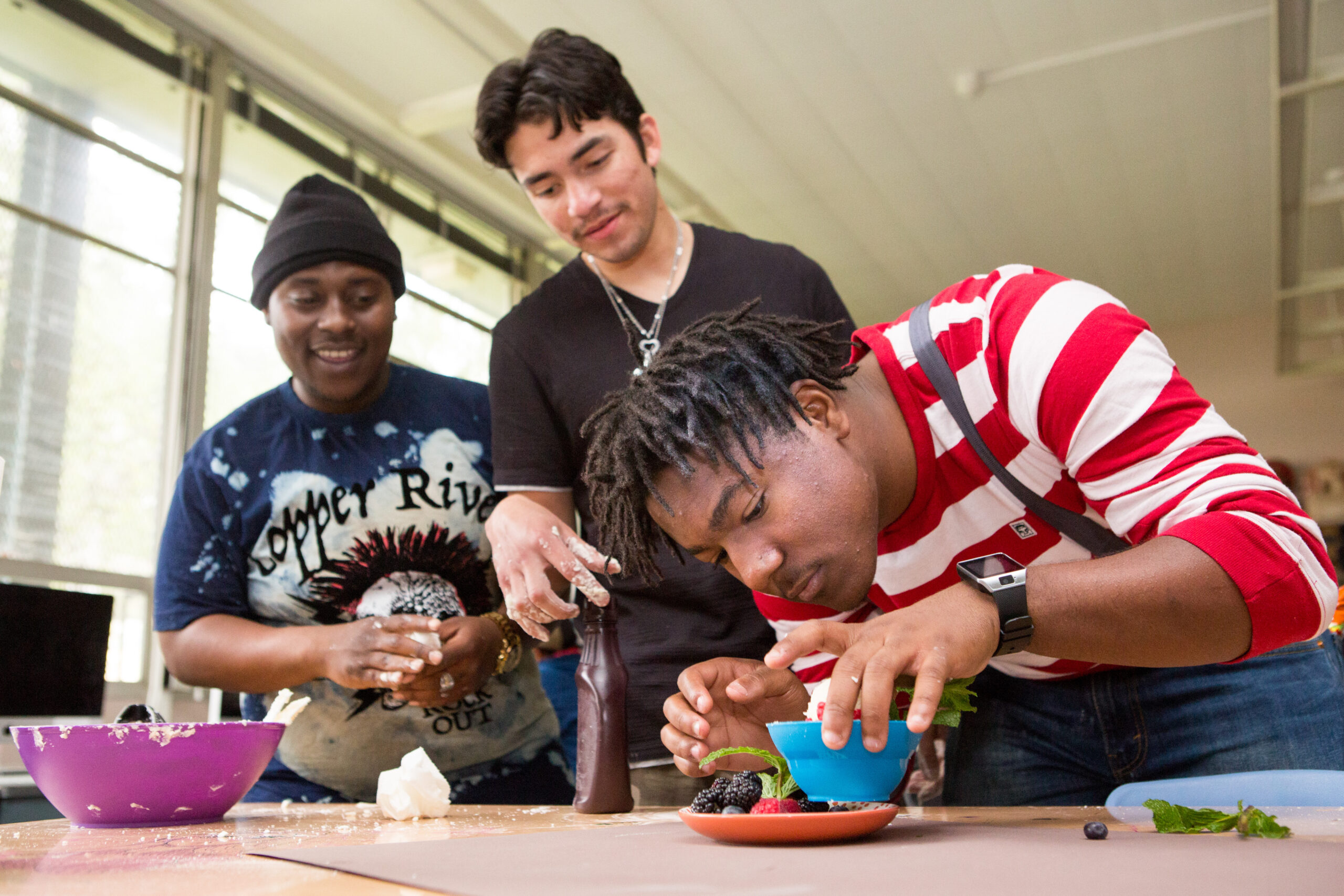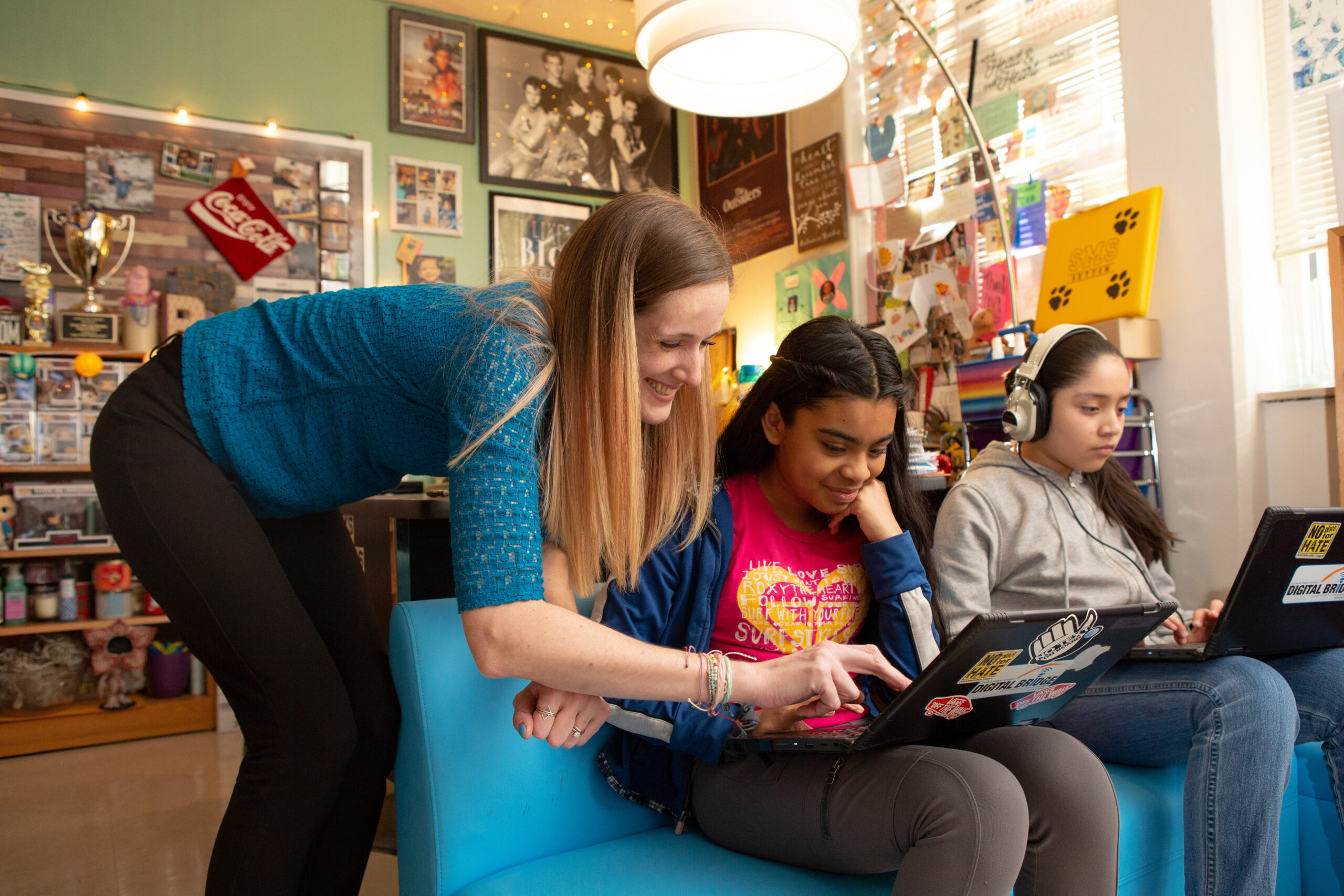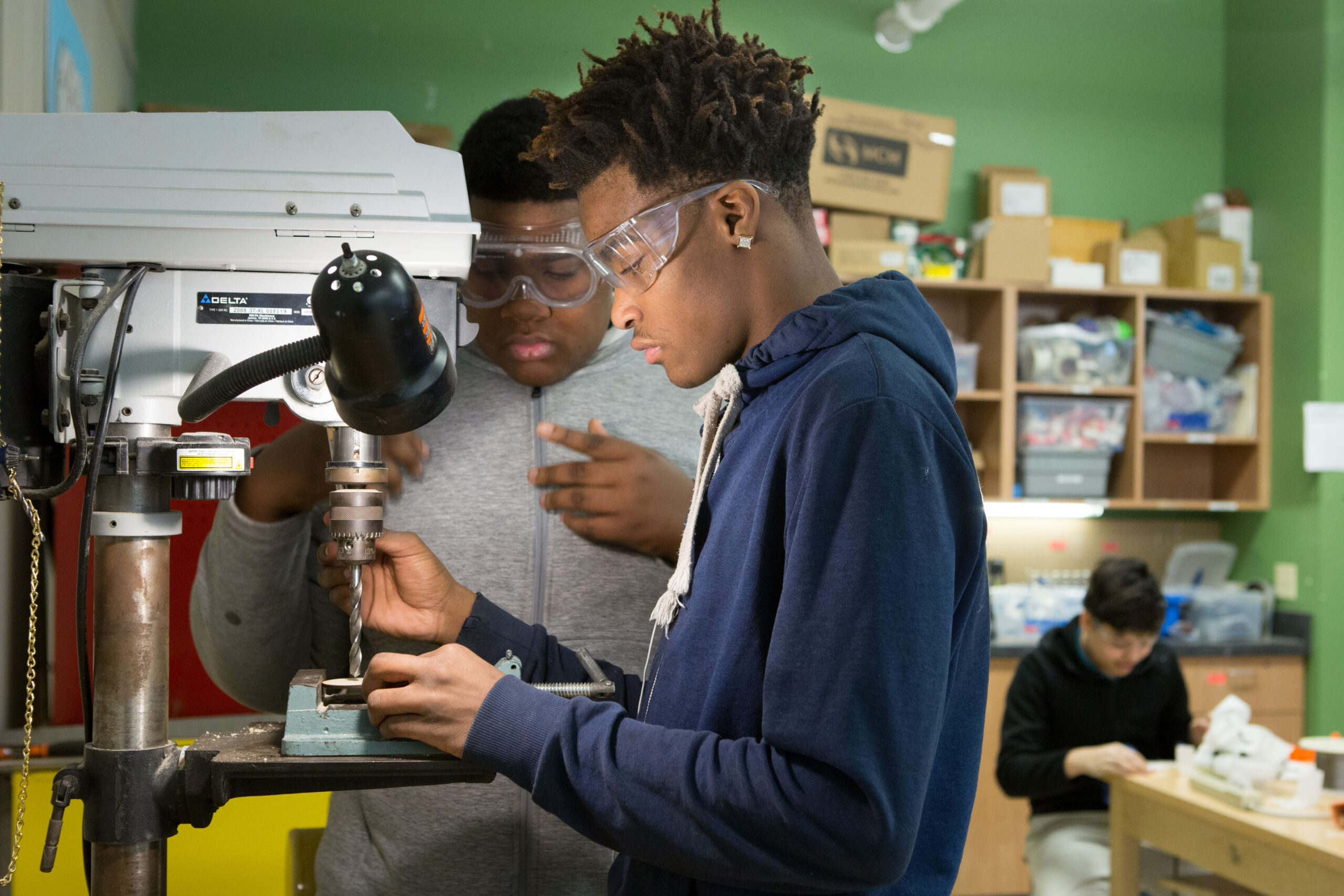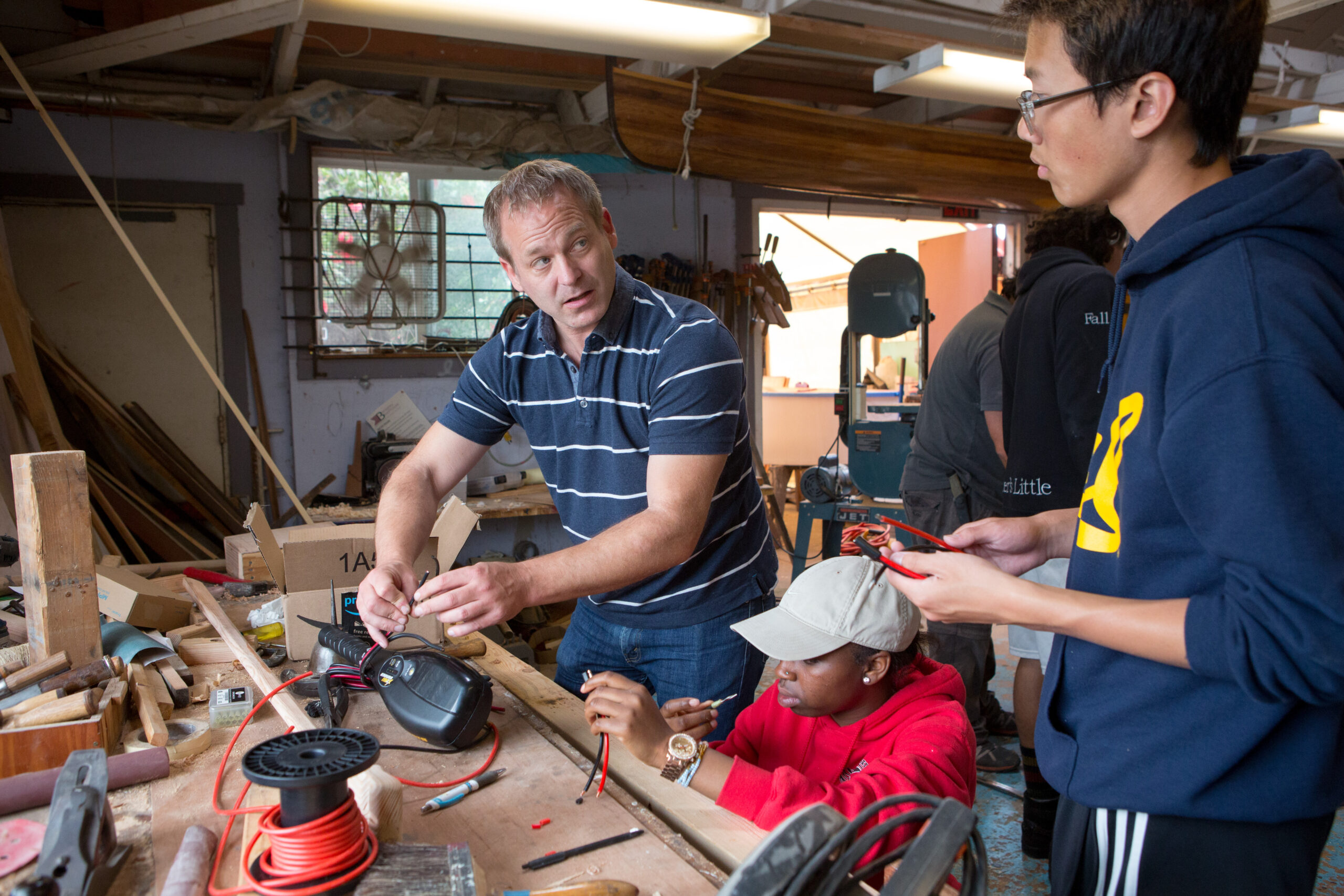What Future Ready Pathways Look Like in Action
Successful implementation isn’t about isolated programs; it’s about designing coherent systems that expand opportunity, reflect community context, and center learner purpose. This means ensuring learners are prepared for both college and career, valuing the flexibility for learners to pursue a degree, a credential, or both, and supporting pathways that blend academic and workforce options. This section offers real-world examples and emerging practices from the field that district and school leaders can use as “look fors” when building or refining their Future Ready Pathways. These are not exhaustive lists or prescriptive models, but they highlight concrete ways that Career-Connected Exploration and the four Future Ready Pathway Design Pillars can come to life at scale.
To support thoughtful planning and continuous improvement, each area includes three complementary tools: Successful Practices (Look-Fors) that describe what strong practices should visibly look like in schools and classrooms, District Reflection Questions that guide leaders to assess readiness, identify priorities, and foster cross-functional conversations, and Action Steps that highlight deeper system-level steps leaders can take to bring those practices to scale. Together, these tools help district teams move beyond surface-level considerations to focus on execution: how opportunities are scaled, how equity is ensured, and how experiences connect to postsecondary success.
Career-Connected Exploration
The successful implementation of career-connected exploration begins early and is integrated into everyday learning. In high-quality systems, learners engage in meaningful experiences that help them discover their interests and connect classroom learning to the world of work. From career-themed academic activities to partnerships with local professionals and community-based field trips, strong exploration systems are inclusive, identity-affirming, and developmentally appropriate. In alignment with the broader vision for Future Ready Pathways, exploration is an and/and: it develops early awareness of college options (two- and four-year degrees, affordability) and requirements, while simultaneously building workforce interest and fluency (knowledge, skills, and industry-recognized credentials).

Action Steps:
To ensure these practices happen consistently and equitably, districts and schools can also:
- Develop a K–12 exploration progression that defines expectations for exposures and portfolio artifacts by grade band.
- Integrate every exploration experience into learner plans, connecting it to related courses, credits, or credentials.
- Embed short “college and career minute” micro-lessons in advisory to build literacy around terms like transfer credit, articulation, or workplace rights.
- Support learners in creating future pathway maps. (Ex. See Leyden SD (IL) spotlight.)
- Conduct equity audits of speakers, field trips, and mentors to ensure diversity of demographics and pathways, then address gaps with targeted outreach.
- Align exploration artifacts to academic standards and Portrait of a Graduate competencies, embedding them into assessment and feedback systems.
- Host quarterly family academies on topics like college affordability, FAFSA, apprenticeships, and pathway opportunities.
- Integrate exploration artifacts into learner portfolios, reviewed and discussed with families.
- Establish formal MOUs with colleges and employers that outline expectations for learner artifacts, feedback, and possible shared data.
- Redesign schedules to include flexible exploration blocks, ensuring time for experiences without reducing access to rigorous core instruction.
Career-connected exploration lays the foundation for every other pillar of Future Ready Pathways. When learners see themselves reflected in multiple postsecondary routes and build awareness of both college and workforce options, they begin to form a sense of purpose and agency. These early experiences are not about choosing a single destination but about opening doors and expanding what learners believe is possible. As districts strengthen exploration, the next step is to ensure that learners have the advising and navigation supports to turn curiosity into clear plans for action.

Photo by Allison Shelley for EDUimages
Pillar 1: College and Career Advising and Navigation
High-quality advising ensures that learners are not left to navigate the complexity of postsecondary choices on their own. Advising systems should help learners explore their interests, set goals, and understand the steps needed to pursue them. It’s vital for learners to make informed decisions about course selection and other pathway experiences so they will be positioned to make choices about their postsecondary journeys. Choices should not be made for them based on their lack of preparation. Strong systems go beyond course selection; they integrate career exploration, financial planning, and navigation of both college and workforce pathways. Advising is not a one-time conversation, but an ongoing, developmentally appropriate process that builds at each level and continues throughout high school, ensuring learners graduate with a personalized, clear, and actionable plan.
Successful Practices:
- Districts recognize that college and career conversations are an and/and, not an either/or, and understand the fluid relationship between the two.
- Individual Career and Academic Plans are developed starting in middle school and updated annually to guide learner reflection and planning, ideally in a one-on-one setting, having multiple touch points per year.
- Districts prioritize the human connection and relationships necessary for successful advising and strategically employ artificial intelligence or other technology tools.
- For states that require Individual Plans of Study for middle and high school learners, align pathway work to state-wide requirements.
- Multi-tiered advising systems that include academic counseling, postsecondary planning, and wellness supports.
- Advising is embedded into the academic day through advisory periods, SEL integration, or project-based learning.
- Mentoring programs pair learners with trusted adults, alumni, or community partners for personalized support and guidance.
- Success Coaches or pathway navigators provide individualized, relationship-based guidance.
- Use of data and diagnostics (e.g., interest inventories, skills assessments, labor market data) to personalize advising.
- Equity-focused training for counselors, advisors, and teachers to support culturally responsive guidance.
- Learner-led conferences, where learners present their academic and career plans to families and educators.
- Technology tools that support career planning, learner reflection, and access to virtual mentorship.
- Partnerships with youth-serving organizations and workforce boards to expand advising reach and real-world alignment.
- Advising outcome tracking disaggregated by learner group to monitor effectiveness and equity.
- Financial literacy and college affordability advising are embedded into career navigation systems to support informed postsecondary decision-making.
- Early FAFSA support and postsecondary financial planning workshops begin in early high school.
District Reflection Questions
- How equitable is access to advising supports across schools and learner groups?
- Do all learners have personalized plans that are meaningful, updated annually, and connected to graduation and postsecondary planning?
- How are families engaged in advising, financial literacy, and navigation of both college and career pathways?
- What professional learning is provided for school counselors and teachers to keep advising aligned with evolving college, career, and labor market trends?
- How are advising systems integrated into daily schedules to ensure universal participation?
- Which learner groups are underrepresented in dual enrollment, advanced coursework, or credential pathways, and how are advising practices addressing these gaps?
- Do our advising platforms and tools provide accurate, transparent information on college outcomes and labor market opportunities?
- How do we track advising outcomes, such as FAFSA completion, postsecondary enrollment without remediation, and certificate completion, while monitoring possible equity gaps?
Action Steps:
To ensure these practices happen consistently and equitably, districts and schools can also:
- Develop a districtwide advising framework with clear expectations for frequency, scope, and documentation of advising.
- Integrate learner plans into Student Information System (SIS) platforms so they are accessible to learners, families, and educators.
- Provide job-embedded professional learning for advisors and teachers on culturally sustaining advising and labor market changes.
- Embed financial planning modules into advising, including FAFSA, debt-to-income considerations, and scholarship navigation.
- Formalize partnerships with higher ed institutions to ensure advising on admissions, transfer pathways, and academic success skills.
- Build data dashboards that monitor advising participation, learner post-secondary decisions, and where possible, postsecondary outcomes.
- Schedule annual learner-led conferences that involve families and reinforce agency in pathway planning.
- Align advising with community-based organizations to provide wraparound supports, particularly for historically underserved learners.
- Conduct annual equity reviews of advising outcomes and adjust strategies to address identified gaps.
Advising is the connective tissue of Future Ready Pathways. It transforms exploration into action by giving learners the tools, guidance, and confidence to navigate complex choices. When advising is equitable, culturally sustaining, and embedded into the daily fabric of schools, learners graduate with clarity about their next steps and confidence in their ability to pursue them. With strong advising systems in place, districts can leverage the next pillar, Dual Enrollment, to ensure learners’ plans translate into meaningful, credit-bearing opportunities that accelerate both college and career success.

Photo by Allison Shelley for EDUimages
Pillar 2: Dual Enrollment
Dual enrollment creates opportunities for learners to earn college credit while still in high school, saving time and money on postsecondary education while building confidence in academic readiness. High-quality systems remove barriers such as tuition, transportation, and eligibility requirements; ensure credits are transferable; and align courses with learners’ postsecondary and career goals. Dual enrollment should be viewed as a college-and-career accelerator, helping learners reduce the cost of a degree while also connecting to workforce-aligned credentials and pathways.
Please reference the Career-Connected Exploration & Four Design Pillars section for our acknowledgement of other “college in high school” options and considerations therein.
Successful Practices:
- Tuition-free dual enrollment opportunities are accessible to all learners, with targeted supports for historically underserved groups.
- Opportunities prioritize learner needs, including transportation, childcare for student parents, and meals, if courses are off campus.
- A sequence of 12 dual enrollment credits is available, and strategically aligns with meaningful post-secondary experiences, avoiding the prevalent “random acts of dual enrollment”.
- Guaranteed credit transfer agreements are in place with two- and four-year institutions, ensuring credits apply directly toward degree requirements.
- Advising systems help learners and families understand dual enrollment options, eligibility, and long-term implications for postsecondary planning.
- Bridge courses and supports (e.g., study skills, college success, tutoring) prepare learners for success in rigorous dual enrollment classes.
- Teacher credentialing pathways allow high school faculty to become qualified dual enrollment instructors in partnership with higher education.
- Dual enrollment offerings include both academic transfer and CTE/technical options, ensuring learners have multiple pathways to credit.
- Partnerships with local colleges and universities expand access to diverse course offerings, both on campus and virtually.
- Participation data is monitored by subgroup to identify and close gaps in access, credit accumulation, and success rates.
- Financial literacy and college affordability advising are integrated to help families understand cost obligations and possibilities.
- Postsecondary faculty collaboration with high school teachers ensures alignment in curriculum rigor and learner expectations.
- Learners’ earned credits are tracked transparently and communicated as progress toward degrees, not just high school graduation.
District Reflection Questions:
- How accessible are dual enrollment opportunities across all schools and learner groups in the district?
- Do our dual enrollment credits consistently transfer toward degrees at two- and four-year partner institutions? How do we know?
- How balanced are our offerings between academic transfer courses and applied technical/CTE courses?
- Which learner groups are underrepresented in dual enrollment, and what targeted supports are in place to improve access and success?
- How are families engaged in understanding dual enrollment benefits, transferability, and financial implications?
- What professional learning is provided to school counselors and teachers to ensure accurate, up-to-date advising on dual enrollment?
- How are we monitoring learner success in dual enrollment courses, including persistence, completion, and impact on postsecondary outcomes?
Action Steps
To ensure dual enrollment is equitable, coherent, and impactful, districts and schools can:
- Develop (or expand) formal articulation and transfer agreements with higher education partners, guaranteeing credit transferability.
- Expand access by covering tuition, fees, and transportation through state funds, grants, or district support.
- Create a districtwide communication strategy to ensure learners and families clearly understand dual enrollment opportunities – including cost savings associated with accruing college credit while in high school.
- Offer early bridge courses and academic supports to prepare learners for the rigor of dual enrollment.
- Develop certification pathways for high school teachers to become dual enrollment instructors.
- Monitor disaggregated participation data and intervene when equity gaps appear.
- Utilize data dashboards that track learner credit accumulation toward degrees and credentials.
- Align dual enrollment offerings with both academic and technical pathways, ensuring relevance for diverse learner goals.
- Celebrate learner milestones publicly (e.g., associate’s degree completions, credential attainment before graduation) to reinforce the value of dual enrollment.
Dual enrollment bridges high school, college, and career by providing learners with tangible progress toward postsecondary success. When systems are equitable, aligned, and supported, dual enrollment can be transformative, reducing costs, shortening time to degree, and expanding access to high-quality credentials. With robust dual enrollment in place, the next pillar, Work-Based Learning, ensures learners have authentic opportunities to apply their academic knowledge in real-world settings while building the skills and experiences valued by both colleges and employers.

Photo by Allison Shelley for EDUimages
Pillar 3: Work-Based Learning
Leading Note: It’s imperative that district leaders are familiar with relevant state laws regarding work-based experiences and use them as guardrails for the opportunities that they offer.
Work-based learning (WBL) connects classroom learning with authentic workplace experiences. High-quality WBL provides learners with opportunities to apply academic knowledge, build technical and professional skills, and explore career interests in real-world contexts. Experiences may include internships, apprenticeships, job shadowing, cooperative education, and industry projects. When designed with equity at the center, WBL helps all learners, especially those historically underserved, gain the confidence, skills, and networks they need to thrive in both college and career.
Successful Practices:
- Develop a continuum of WBL opportunities from career awareness and job shadowing to paid- internships, pre-apprenticeships, and registered, paid apprenticeships.
- Ensure equitable access by covering costs such as transportation, stipends, or equipment for learners who need financial support.
- Integrate WBL into academic pathways, aligning experiences with learners’ individualized plans and ensuring credit or credential recognition.
- Establish strong partnerships with employers who co-design experiences, set clear expectations, and provide meaningful learner feedback.
- Leverage intermediaries (e.g., workforce boards, chambers, nonprofits) to expand opportunities and manage logistics.
- Provide structured reflection activities that connect workplace learning to academic standards and postsecondary planning.
- Train workplace mentors and supervisors to support learner growth and ensure experiences are inclusive and supportive.
- Embed professional skill development (e.g., communication, collaboration, problem-solving) into WBL activities.
- Use technology platforms to match learners with opportunities, track participation, and capture skills learned.
- Recognize WBL experiences on transcripts and/or learner portfolios, making them visible to colleges and employers.
District Reflection Questions:
- How comprehensive is our continuum of WBL opportunities, from awareness to apprenticeships?
- Which learner groups face barriers to participation, and how are we addressing equity of access (transportation, stipends, supports)?
- How are WBL experiences connected to a learner’s individualized plan, academic pathways, and graduation requirements?
- Do our partnerships with employers reflect the diversity of our local labor market and the aspirations of our learners?
- How are workplace mentors trained to provide inclusive, developmentally appropriate support?
- In what ways are we assessing the quality of WBL beyond participation numbers (e.g., skill growth, learner reflections, employer feedback)?
- How do we capture and validate learner skills from WBL (e.g., transcripts, portfolios, digital badges)?
- How are WBL outcomes used to inform continuous improvement of pathways and partnerships?
Action Steps:
To strengthen and scale work-based learning, districts and schools can:
- Map a K–12 WBL continuum that builds from awareness to advanced opportunities, ensuring intentional progression.
- Formalize employer partnerships with MOUs that define expectations, feedback loops, and learner safety supports.
- Provide stipends or cover costs (e.g., uniforms, tools, transportation) to eliminate financial barriers for participation.
- Embed reflection and assessment into WBL, requiring learners to connect experiences to academic standards and individualized learning plans.
- Develop teacher externship programs to help educators understand industry expectations and integrate them into their instruction.
- Leverage intermediaries or regional partners to expand access, coordinate placements, and share resources.
- Create a WBL monitoring system to analyze participation, equity, skill development, and postsecondary outcomes.
- Recognize and credential WBL experiences, including transcript notation, digital badges, or credits.
- Provide mentor training for employers and supervisors to ensure consistent, high-quality learner support.
- Showcase learner WBL experiences through presentations, portfolios, or capstone exhibitions to reinforce value and visibility.
Work-based learning brings relevance to the classroom and helps learners build the skills, confidence, and networks needed for long-term success. By making WBL equitable, intentional, and connected to academic pathways, districts ensure that learners graduate with experiences that distinguish them, whether they are entering college, pursuing a credential, or transitioning directly into the workforce. With WBL in place, the next pillar, Industry-Recognized Credentials, ensures learners leave high school with tangible credentials of value that signal readiness to both colleges and employers.

Photo by Allison Shelley for EDUimages
Pillar 4: Industry-Recognized Credentials
Industry-recognized credentials (IRCs) give learners tangible evidence of their skills and knowledge that is valued in both college and the workforce. Many credentials offered to high school learners are of low quality with little labor-market value. High-quality credentials are stackable, portable, aligned to labor market demand, and connected to postsecondary pathways. When embedded into coherent pathways, credentials can accelerate degree completion, enhance employability, and provide learners with the confidence and agency to pursue their futures. Equitable access to high-value credentials ensures that all learners, not just a select few, graduate with opportunities that open doors, whether continuing education or entering the workforce.
Successful Practices:
- Embed credentials into academic and CTE pathways, ensuring they connect to postsecondary degrees and career opportunities.
- Prioritize high-value credentials that are stackable, portable, and aligned with state and regional labor market demand.
- Remove financial barriers by covering exam fees, equipment, or certification costs for learners.
- Map credential-to-credit crosswalks with higher education partners to enable learners to gain advanced standing toward their degrees.
- Integrate credential preparation into coursework, making it part of the learning process rather than an add-on.
- Track credential attainment data disaggregated by learner group to identify and close equity gaps.
- Provide credentialing opportunities across multiple sectors, giving learners flexibility and options.
- Integrate credentials into learner portfolios to be visible to colleges and employers.
- Establish partnerships with employers and workforce boards to validate credential value and keep offerings aligned to demand.
- Celebrate credential attainment publicly to reinforce the importance of learner achievement and expand community awareness.
District Reflection Questions:
- Which credentials offered in our district are valued by both colleges and employers and lead to high-wage, high-demand opportunities? Which credentials don’t and should be reevaluated?
- How are credentials embedded into pathways, rather than offered as stand-alone experiences?
- Which learner groups are underrepresented in earning credentials, and what strategies are in place to close participation and attainment gaps?
- Do our credentials align with state-approved high-value lists or regional labor market demand?
- How are credentials recognized for postsecondary credit or advanced standing at partner institutions?
- What supports (financial, academic, advising) are provided to ensure learners complete credential requirements successfully?
- How do we track credential attainment, and how is that data used for continuous improvement and equity monitoring?
- In what ways are employers, workforce boards, and higher ed partners co-designing and validating credential offerings?
Action Steps:
To strengthen access to and impact of credentials, districts and schools can:
- Audit current credential offerings to identify which are truly high-value and eliminate low-return options.
- Expand formal credential-to-credit agreements with higher education institutions.
- Create funding strategies to cover credential exam fees, equipment, and other costs for learners.
- Integrate credential prep into courses, aligning assessments and curriculum to certification standards.
- Build data dashboards that monitor credential attainment by subgroup and link results to other desired outcomes.
- Engage employers and workforce boards in regularly reviewing credential lists to ensure alignment with regional demand.
- Expand credential offerings across multiple pathways (healthcare, IT, manufacturing, education, etc.) to honor learner choice.
- Launch digital portfolios so learners can showcase credentials in resumes, applications, and online profiles.
- Provide professional learning for teachers on embedding credential preparation into coursework.
- Celebrate and publicize credential attainment, recognizing learners at school events, board meetings, and community showcases.
Industry-recognized credentials (IRCs) give learners an advantage as they step into their futures, providing them with evidence of skills that hold value in both college and the workforce. When districts prioritize high-quality, high-value credentials and remove barriers to access, they ensure learners graduate not only with diplomas but also with credentials that open doors into a hopeful future. With all four pillars in place, College and Career Advising and Navigation, Dual Enrollment, Work-Based Learning, and Industry-Recognized Credentials, Future Ready Pathways create coherent, learner-centered systems that expand opportunity, close equity gaps, and prepare each learner with known, actionable steps for success, regardless of the path forward they choose.
Bringing Successful Practices to Life
The successful implementation of Future Ready Pathways doesn’t happen by chance; it happens by intentional design. The practices in this section are not a one-size-fits-all model. Instead, they provide tangible examples of what quality, equity, and intentionality look like in action. They serve as “look fors” that help school and district leaders assess current efforts, identify areas for growth, and build systems that are coherent, learner-centered, and community-connected. By grounding these practices in a local context and aligning them with the broader design pillars, schools can transition from isolated programs to fully integrated Future Ready Pathways that prepare learners for both college and career success, ultimately leading to purposeful lives.
Ultimately, these practices embody a national call to action: to develop agile, modern systems that equip each learner for postsecondary education, career advancement, and purpose-driven lives, while meeting the evolving needs of a workforce and economy.

